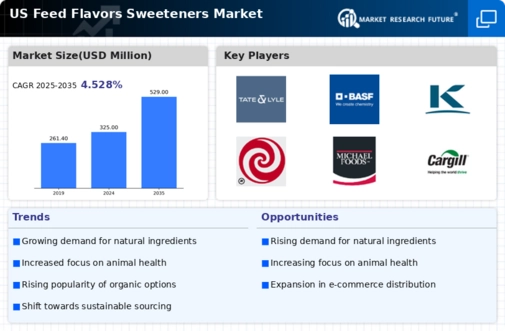Growth of the Pet Food Sector
The growth of the pet food sector is significantly contributing to the expansion of the feed flavors-sweeteners market. As pet ownership continues to rise in the US, there is an increasing demand for high-quality pet food that includes appealing flavors and sweeteners. Pet owners are becoming more discerning, seeking products that not only meet nutritional needs but also enhance palatability. In 2025, the pet food segment is expected to account for nearly 25% of the overall feed flavors-sweeteners market, indicating a robust opportunity for manufacturers to innovate and cater to this lucrative segment. This trend underscores the importance of flavor and sweetness in driving consumer choices in the pet food industry.
Rising Demand for Nutritional Enhancements
The feed flavors-sweeteners market is experiencing a notable increase in demand for nutritional enhancements in animal feed. This trend is driven by the growing awareness among livestock producers regarding the importance of nutrition in improving animal health and productivity. As consumers become more health-conscious, there is a parallel rise in the demand for high-quality animal products. In 2025, the market for feed flavors and sweeteners is projected to reach approximately $1.5 billion in the US, reflecting a compound annual growth rate (CAGR) of around 5%. This growth is indicative of the industry's response to the need for improved feed formulations that enhance palatability and nutritional value, thereby supporting the overall health of livestock.
Technological Advancements in Feed Production
Technological advancements in feed production are significantly influencing the feed flavors-sweeteners market. Innovations in processing techniques and formulation technologies allow for the development of more effective flavoring and sweetening agents. These advancements not only enhance the sensory appeal of feed but also improve the bioavailability of nutrients. The integration of precision nutrition and data analytics in feed formulation is becoming increasingly prevalent, enabling producers to tailor feed to specific animal needs. As a result, the feed flavors-sweeteners market is likely to see a surge in demand for customized solutions that cater to diverse livestock requirements, potentially leading to a market valuation of $1.7 billion by 2026.
Consumer Preferences for Sustainable Practices
Consumer preferences for sustainable practices are reshaping the feed flavors-sweeteners market. As the demand for sustainably sourced animal products rises, livestock producers are increasingly seeking feed additives that align with these values. This shift is prompting manufacturers to develop flavors and sweeteners derived from natural and organic sources. In 2025, it is estimated that around 30% of the feed flavors-sweeteners market will be attributed to organic products, reflecting a growing trend towards environmentally friendly practices. This change not only meets consumer expectations but also enhances the market's appeal to a broader audience, potentially driving sales and market growth.
Regulatory Changes and Compliance Requirements
Regulatory changes and compliance requirements are pivotal factors impacting the feed flavors-sweeteners market. The US government has implemented stricter regulations regarding the use of additives in animal feed, necessitating that manufacturers adapt their formulations to comply with these standards. This regulatory landscape encourages innovation within the industry, as companies strive to develop compliant products that do not compromise on quality or efficacy. The feed flavors-sweeteners market is likely to see increased investment in research and development to meet these evolving regulations, which could lead to a market size of approximately $1.6 billion by 2026.


















Leave a Comment